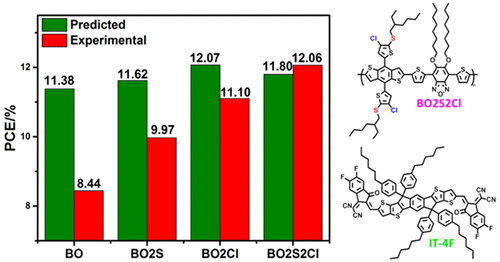当前位置:
X-MOL 学术
›
ACS Appl. Polym. Mater.
›
论文详情
Our official English website, www.x-mol.net, welcomes your
feedback! (Note: you will need to create a separate account there.)
Atom-Varied Side Chains in Conjugated Polymers Affect Efficiencies of Photovoltaic Devices Incorporating Small Molecules
ACS Applied Polymer Materials ( IF 4.4 ) Pub Date : 2019-12-27 , DOI: 10.1021/acsapm.9b00998 Yu-Che Lin, Chung-Hao Chen, Ren-Hao Li, Cheng-Si Tsao, Akinori Saeki, Hao-Cheng Wang, Bin Chang, Lin-Yun Huang, Yang Yang, Kung-Hwa Wei
ACS Applied Polymer Materials ( IF 4.4 ) Pub Date : 2019-12-27 , DOI: 10.1021/acsapm.9b00998 Yu-Che Lin, Chung-Hao Chen, Ren-Hao Li, Cheng-Si Tsao, Akinori Saeki, Hao-Cheng Wang, Bin Chang, Lin-Yun Huang, Yang Yang, Kung-Hwa Wei

|
We synthesized three conjugated polymers involving sulfur (S)-inserted and chlorine (Cl)-substituted side chains of the parent two-dimensional conjugated polymer—poly(benzodithiophene–thiophene–benzooxadiazole) (BO)—to form S-inserted (BO2S), Cl-substituted (BO2Cl), and S-inserted with Cl-substituted (BO2S2Cl) polymers for tuning their surface energies and, thus, interaction with IT-4F small molecule in their binary blends. In the BO:IT-4F blend, the bulk heterojunction (BHJ) structure was constituted mainly from the long-rod BO domains along with a few IT-4F domains that dispersed well in the blend; in contrast, favorable networks for charge transport existed in the BO2S or BO2S2Cl with IT-4F blend. The disk sizes of IT-4F in the BO2S2Cl:IT-4F blend were larger than that in the BO2S:IT-4F blend (23.3 vs 18.1 nm). As the extent of atom variation increased from BO to BO2S to BO2S2Cl, the induced IT-4F crystallinity increased, and the orientation of molecular packing of the polymer varied. The highest PCE (12.06%) was that for the device based on the double sulfur-inserted/chlorine-substituted side chain polymer and IT-4F acceptor (BO2S2Cl:IT-4F), owing to the more balanced hole-to-electron mobility, being consistent with the value predicted (11.8%) using the random forest machine learning model. This study not only provides insight into the photovoltaic performance of the polymers with atom-inserted or -substituted side chain but also reveals that the effects of molecular packing.
中文翻译:

共轭聚合物中的原子变化侧链会影响结合了小分子的光伏器件的效率。
我们合成了涉及母体二维共轭聚合物聚(苯并二噻吩–噻吩–苯并恶二唑)(BO)的硫(S)和氯(Cl)取代的侧链的三种共轭聚合物,形成了S插入(BO2S) ,Cl取代的(BO2Cl)和S取代的Cl取代的(BO2S2Cl)聚合物,以调节其表面能,从而与二元共混物中的IT-4F小分子相互作用。在BO:IT-4F共混物中,本体异质结(BHJ)结构主要由长杆BO结构域以及少量在该共混物中良好分散的IT-4F结构域组成。相反,在带有IT-4F混合物的BO2S或BO2S2Cl中存在有利的电荷传输网络。BO2S2Cl:IT-4F共混物中IT-4F的磁盘尺寸大于BO2S:IT-4F共混物中IT-4F的磁盘尺寸(23.3 vs 18.1 nm)。随着原子变化程度的增加,从BO到BO2S到BO2S2Cl,诱导的IT-4F结晶度增加,并且聚合物的分子堆积方向发生变化。最高的PCE(12.06%)是基于双硫插入/氯取代的侧链聚合物和IT-4F受体(BO2S2Cl:IT-4F)的器件,这是因为其空穴电子迁移率更加平衡,与使用随机森林机器学习模型预测的值(11.8%)一致。该研究不仅提供了对具有原子插入或取代的侧链的聚合物的光伏性能的了解,而且还揭示了分子堆积的作用。(06%)是基于双硫插入/氯取代的侧链聚合物和IT-4F受体(BO2S2Cl:IT-4F)的设备,因为它具有更平衡的空穴-电子迁移率,与使用随机森林机器学习模型预测的值(11.8%)。该研究不仅提供了对具有原子插入或取代的侧链的聚合物的光伏性能的了解,而且还揭示了分子堆积的作用。(06%)是基于双硫插入/氯取代的侧链聚合物和IT-4F受体(BO2S2Cl:IT-4F)的设备,因为它具有更平衡的空穴-电子迁移率,与使用随机森林机器学习模型预测的值(11.8%)。该研究不仅提供了对具有原子插入或取代的侧链的聚合物的光伏性能的了解,而且还揭示了分子堆积的作用。
更新日期:2019-12-29
中文翻译:

共轭聚合物中的原子变化侧链会影响结合了小分子的光伏器件的效率。
我们合成了涉及母体二维共轭聚合物聚(苯并二噻吩–噻吩–苯并恶二唑)(BO)的硫(S)和氯(Cl)取代的侧链的三种共轭聚合物,形成了S插入(BO2S) ,Cl取代的(BO2Cl)和S取代的Cl取代的(BO2S2Cl)聚合物,以调节其表面能,从而与二元共混物中的IT-4F小分子相互作用。在BO:IT-4F共混物中,本体异质结(BHJ)结构主要由长杆BO结构域以及少量在该共混物中良好分散的IT-4F结构域组成。相反,在带有IT-4F混合物的BO2S或BO2S2Cl中存在有利的电荷传输网络。BO2S2Cl:IT-4F共混物中IT-4F的磁盘尺寸大于BO2S:IT-4F共混物中IT-4F的磁盘尺寸(23.3 vs 18.1 nm)。随着原子变化程度的增加,从BO到BO2S到BO2S2Cl,诱导的IT-4F结晶度增加,并且聚合物的分子堆积方向发生变化。最高的PCE(12.06%)是基于双硫插入/氯取代的侧链聚合物和IT-4F受体(BO2S2Cl:IT-4F)的器件,这是因为其空穴电子迁移率更加平衡,与使用随机森林机器学习模型预测的值(11.8%)一致。该研究不仅提供了对具有原子插入或取代的侧链的聚合物的光伏性能的了解,而且还揭示了分子堆积的作用。(06%)是基于双硫插入/氯取代的侧链聚合物和IT-4F受体(BO2S2Cl:IT-4F)的设备,因为它具有更平衡的空穴-电子迁移率,与使用随机森林机器学习模型预测的值(11.8%)。该研究不仅提供了对具有原子插入或取代的侧链的聚合物的光伏性能的了解,而且还揭示了分子堆积的作用。(06%)是基于双硫插入/氯取代的侧链聚合物和IT-4F受体(BO2S2Cl:IT-4F)的设备,因为它具有更平衡的空穴-电子迁移率,与使用随机森林机器学习模型预测的值(11.8%)。该研究不仅提供了对具有原子插入或取代的侧链的聚合物的光伏性能的了解,而且还揭示了分子堆积的作用。











































 京公网安备 11010802027423号
京公网安备 11010802027423号